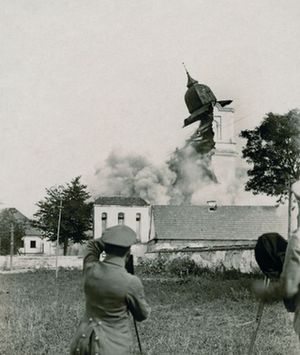The Great War in the East (1914-1918). From the Baltic to the Carpathian Mountains
wydarzenia archiwalne
Featuring material from Tomasz Kuba Kozłowski’s personal collections
The First World War is associated, above all, with the Western Front. The massacres at Ypres and Verdun, the battles on the Marne, the Somme and and Aisne overshadowed the East. These images are preserved in spectacular photographs. The iconography of the Eastern Front is far more modest and almost unknown. And yet, already in the first year of the Great War, fierce battles were taking place in Eastern Prussia, in the Kingdom of Poland and in Western Galicia. In the summer of 1915, the front line began to creep eastwards, stretching from the Baltic to the sweep of the Carpathian Mountains. Fierce fighting took place in the wildernesses of Lithuania and the lakes of the Province of Wilno, in the valleys of the tributaries of the River Dniester in Galicia, in the wild Carpathian Mountains and the gorges of Bukowina and Bessarabia. Even in the consciousness of Poles, the Eastern Front of the First World War is almost exclusively an epic tale of the Polish Legions, or the fate of the Polish Corps in Russia. And yet, on the Eastern Front – from Riga to Czernowiec – it was primarily the armies of the German Empire and the Austro-Hungarian Empire which fought in these parts. The exhibition presents an image of the second, and largest, theatre of military action in Europe.
The aim of the exhibition is not to point out the course of the military action but to demonstrate how the war machine functions, to show life at the front and in the frontal sectors – even in its most human daily terms – and also the results of the war for the lands and civilian peoples involved in it. The author commences his tale of the Great War in the East with a recollection of the image of Central and Eastern Europe before the outbreak of this conflict. He pays comparatively little attention to the familiar ‘Polish dimension’. The material presented in the exhibition reveals a complicated mosaic which – apart from the Poles from the three partitioned areas of Poland – which included troops from Germany (including Alsace and Lorraine); the multi-national Empire and Dual Monarchy comprising Austria, Hungary, Bohemia, Moravia, Galicia, Bukowina, Transylvania, Slovenia, Croatia, Bosnia, Montenegro, Dalmatia and the Russian armies which, apart from Russians and Poles, also deployed Lithuanians, Byelorussians, Ukrainians, Fins, Germans from Courland and Cossacks, Kalmuks, Tatars and Bashkirs recruited from the very depths of the Russian Empire.
A considerable part of the exhibition has been devoted to the everyday aspects of the war. In view of the positional nature of this conflict and a front line which stretched through rural, rather than urbanised territory, the realities of this war differed considerably to those of the Second World War. Photographs of the trenches reveal a surprising picture of monotony and an atmosphere of expectation. Equally surprising are the images of the creative structures of war zone architecture which sprang up to the rear of the frontline: entire estates of dug-outs, Soldiers’ Clubs, chapels and cinemas. The lives of troops withdrawn to the rear and quartered in villages or country houses were also preserved for posterity in photographs.
The enormity of destruction caused by the Second World War and its vast number of victims, overshadowed that of the Great War. While Wilno and Lwów escaped destruction, dozens of smaller towns were laid waste, country estates were destroyed, as were railway stations, factories and bridges. Twenty years would elapse before the Republic of Poland, reborn in 1918, would regain its 1913 level of industrial production – a year before the outbreak of the next world war. Hundreds of cemeteries are a reminder of those who fell in the First World War; graves with names and surnames marked the place of rest of soldiers of the Central Powers who had been issued dog-tags; Russian soldiers were usually buried anonymously. Thousands of civilians died as a result of disease and dreadful living conditions. Victims also included refugees, only a minority of whom managed to return to their homes.
Photo above: German sappers blow up the tower of the Baroque Church of St. Michael the Archangel, Hołoby nr. Kowel in Volhyn, 1916.
The Author has dedicated the exhibition to the memory of the soldiers and civilians – photographers, illustrators, graphic artists, authors of correspondence and of memoirs who have preserved the memory of the Great War in the East.
'The Great War in the East'
Author: Tomasz Kuba Kozłowski (DSH)
Graphic design: Witold Błażejewski
Coordination: Ewa Mazur (DSH)
Translation: Barbara Herchenreder
The exhibition will be complemented by an album whose authors are Tomasz Kuba Kozłowski and Danuta Błahut-Biegańska
All the photographs and other materials come from Tomasz Kuba Kozłowski’s personal collections
The Great War in the East (1914-1918). From the Baltic to the Carpathian Mountains














